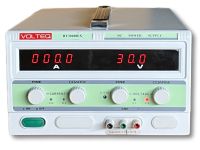FAQs on Adjustable DC Power Supplies
What are the key technologies used in the construction of adjustable DC power supplies?
Key components and technologies used in adjustable DC power supplies include transformers, rectifiers, filters, and voltage regulators. Transformers step up or down the input voltage, rectifiers convert AC to DC, filters smooth out the output waveform, and voltage regulators maintain a stable output voltage across varying load conditions.
What are the primary applications of adjustable DC power supplies across different industries?
Primary applications of adjustable DC power supplies span across industries such as electronics, telecommunications, automotive, aerospace, and research. They are used for testing and development, powering electronic devices, battery charging, and driving electrochemical processes like electroplating and anodizing.
How do linear and switching power supplies differ, and which one is more suitable for specific applications?
Linear power supplies use a transformer to step down the input voltage and a linear regulator to maintain a stable output. They offer low output noise and ripple but are less energy-efficient. Switching power supplies use high-frequency switching to regulate the output voltage, offering higher efficiency but potentially more output noise. The choice depends on the specific application requirements, such as noise sensitivity and energy efficiency.
What factors should be considered when selecting an adjustable DC power supply for a particular application?
Factors to consider when selecting an adjustable DC power supply include voltage and current range, output stability, ripple and noise performance, form factor, cooling method, and control options. It's essential to choose a power supply that meets your application requirements and offers reliability and ease of use.
How can I determine the appropriate voltage and current range for my adjustable DC power supply based on my application requirements?
To determine the appropriate voltage and current range, consider the requirements of your specific application, such as the devices or processes being powered. Ensure that the power supply can deliver the necessary voltage and current levels while providing some headroom for flexibility and future expansion.
What are the essential features to look for in an adjustable DC power supply, such as output stability, ripple, and noise performance?
Essential features to look for in an adjustable DC power supply include output stability (maintaining a constant voltage or current under varying load conditions), low output ripple and noise (minimizing fluctuations that can affect sensitive devices), and user-friendly controls for adjusting voltage and current settings.
How do I properly set up and use an adjustable DC power supply to ensure accurate and stable output for my application?
To properly set up and use an adjustable DC power supply, follow the manufacturer's guidelines for installation, grounding, and ventilation. Connect the power supply to your load, ensuring proper polarity, and use the controls to set the desired voltage and current levels. Monitor the output to ensure stability and make adjustments as needed.
What are the best practices for maintaining and troubleshooting adjustable DC power supplies to ensure their longevity and optimal performance?
Best practices for maintaining and troubleshooting adjustable DC power supplies include regular inspection for loose connections or damaged components, cleaning of cooling systems, and monitoring of performance indicators. Consult the manufacturer's documentation for specific maintenance procedures and troubleshooting steps.
How can I ensure the safety of both the equipment and the user when operating an adjustable DC power supply?
To ensure safety when operating an adjustable DC power supply, follow manufacturer guidelines for installation, grounding, and ventilation. Use proper personal protective equipment, such as gloves and safety glasses, and ensure that personnel are trained in the safe operation and maintenance of the equipment.
What are the latest advancements and trends in adjustable DC power supply technology, and how do they benefit various applications?
Latest advancements and trends in adjustable DC power supply technology include increased energy efficiency, improved output stability and noise performance, and enhanced control options, such as digital interfaces and remote control capabilities. These advancements benefit various applications by offering more precise control, reduced energy consumption, and better integration with other systems.

